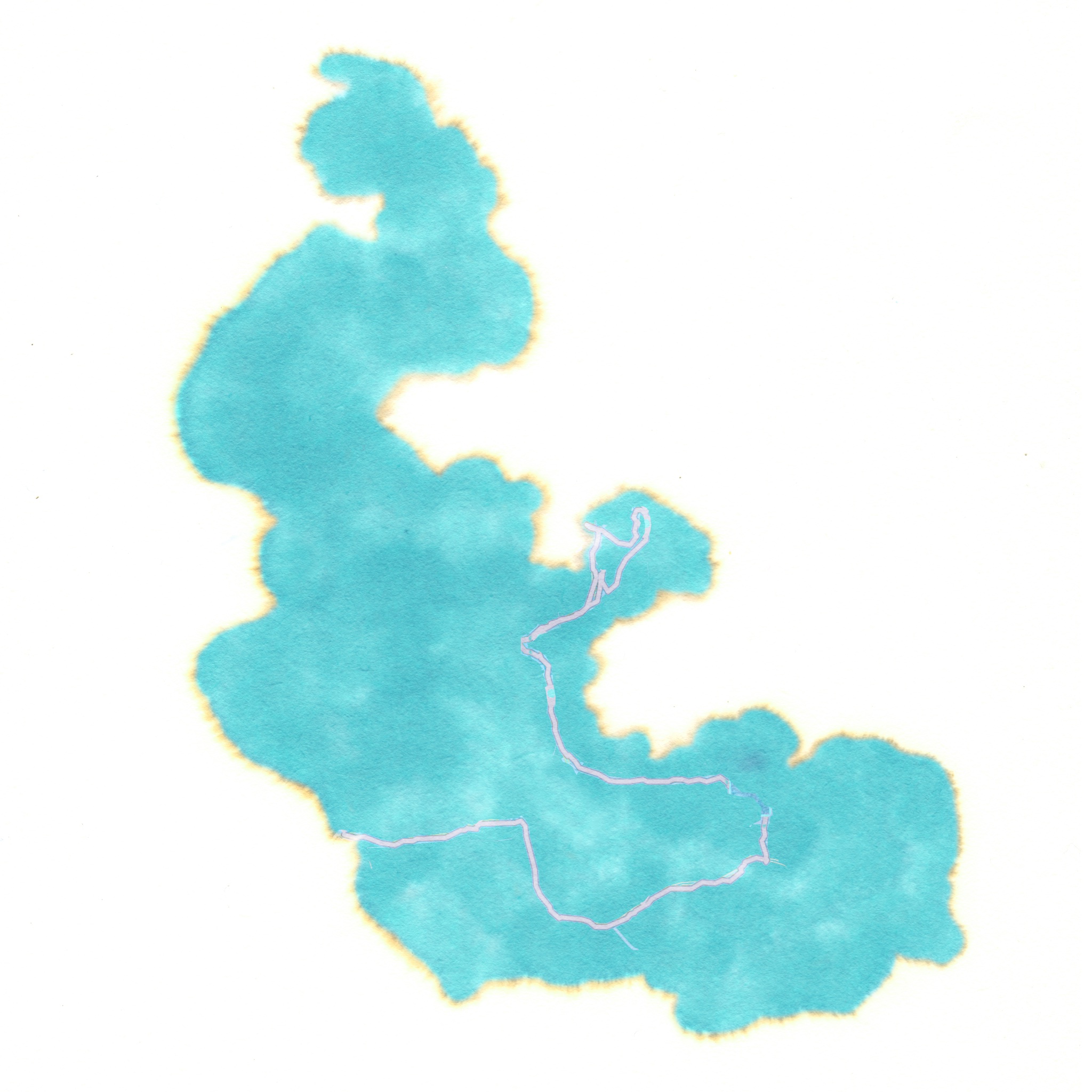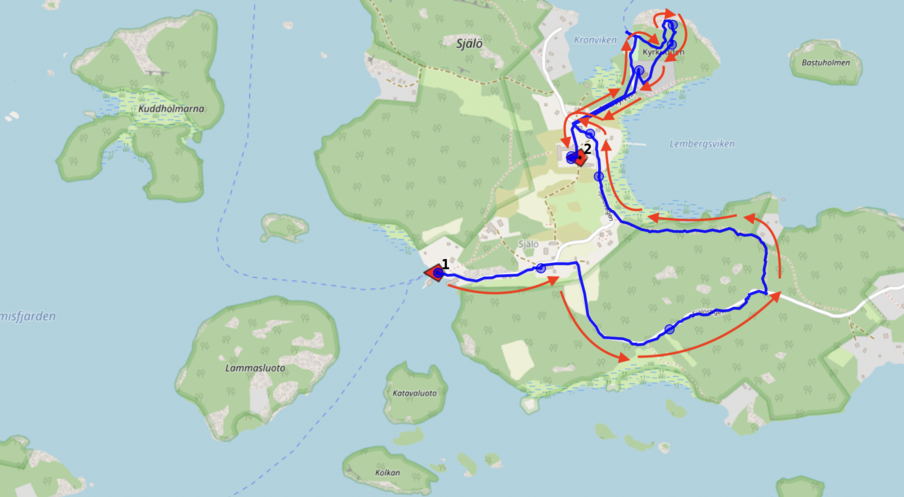Post Glacial Rebound
A soundwalk to encourage intimate connections with the island of Seili. Subtle resonances and disturbances, ecological transformations hovering on the edge of perception. The many sounds of flight. The signalling of plants and plankton. Listening as the biological time of generations intersects with the slow time of tectonic forces.
You can also listen online or download soundtrack as smaller file (82.5 MB)
Quick guide to the Post Glacial Rebound soundwalk
Welcome to Post Glacial Rebound, a soundwalk to encourage intimate connections with the island of Seili and its many inhabitants, human and otherwise.
The soundscape is composed with FoAM's field recordings made on Seili during the spring of 2019 and sonification of time series data collected at The Archipelago Research Institute over several decades. The time series used in the sound walk include oceanographic data (such as temperature, salinity, presence of chlorophyl, and oxygen levels) of the sea surrounding the island. The changes in data over time have been used as variables to modulate the field recordings and synthesized sounds (generated by a custom-made sonification program). Also featuring several plant recordings by Kalle Hamm and the Band of Weeds.
References:
- Archipelago Research Institute: https://sites.utu.fi/seili/en/title/
- Long Term Monitoring Data, collected around Seili Island, Archipelago Sea SW Finland: https://sites.utu.fi/seili/wp-content/uploads/sites/62/2019/12/metadata-seuranta-aineistoille.pdf
- Baltic Herring Research Project: https://sites.utu.fi/herringproject/
Incomplete without surface noise of the Anthropocene, accidental gestures and interference of instruments. Imperfections are an expected part of the process.
More about the soundwalk can be found at https://fo.am/publications/post-glacial-rebound/
Read more about the background and collaboration in this Interview with FoAM Earth
Instructions for a self-guided walk
The walk should take approximately an hour.
Starting point
- Start at the Seili Ferry stop, Postilaituri
- GPS coordinates: 60.23644498717649, 21.9552763835367
End point
- The walk ends at the Gateway to the Archipelago Research Institute's courtyard (also Visit Seili meeting point)
- GPS coordinates: 60.23942068995505, 21.96268743832609
a more detailed map can be found here
Before the walk
This walk includes a soundtrack as part of the experience. You will need a device that can play sound with earbuds or headphones (such as phone or mp3 player) for listening during the walk. The soundfile is one hour long, and the walk should take approximately an hour.
Download the sound from the link above, and check if the sound is working while you're online, but please avoid listening to the soundtrack until you begin the walk. (you can also listen online or download soundtrack as smaller file (82.5 MB)
When you start playback take a few moments to experiment with listening at different volumes. You should be able to hear the recorded sound as part of the current soundscape on the island, so it's best to avoid noise cancelling headphones.
During the walk
As a participant in this walk, we invite you to attune to the island using all your senses.
Pay attention to what you notice around you and what effect the surroundings have on your physical and mental states (your moods, thoughts and emotions).
To begin with, stand still and take a few deep breaths. Acknowledge that you have landed on an island that is slowly, imperceptibly rising above the water, in a process known as the post glacial rebound.
When you start to walk, walk slowly. Slow enough to be able to pay attention to the complex relationships in the environment. Experiment with changing the rhythm of your walking. Notice how you react to a change of pace. If you walk in a group, try to walk in silence, single file or spread out.
Notice your surroundings as you walk. From the vastness of the sky to tiny particles of dust; from the shapes of the trees to the shapes of the fences; from the wholes to their parts and back again. Occasionally stop and look around, or close your eyes and sense the sonic, tactile and olfactory textures of the environment. Take this time to be attentive to the landscape and its inhabitants, animate and inanimate. Notice how your experience changes when moving or standing still.
Pay attention to what is going on around you – other humans, the plants, animals, rocks and water. Notice how you respond to them, without taking any action. Simply allow everything to be as it is. Notice that just by being where you are, you are moving into and out of relationships with multitudes of beings.
After the walk
When your walk comes to an end, take a few moments to reflect on your experience. How did you experience the place, your surroundings, and the various lives unfolding within? Do you have any insights about your relationship with the island?
This sound walk is a work in progress, so your feedback is most welcome! If you do feel up for it, please share your thoughts about the walk with the CAA crew, or contact us at earth at fo dot am
We are particularly keen to hear what you appreciated, and what was challenging; what aspects of the walk you'd like to see more focus on, or what we could improve. As we were unable to test the current composition on the island ourselves (due to the usual plagues and travel complications) we would be very interested in what you have to share with us about the experience.
Thank you!
Nik & Maja, FoAM Earth
credits
Released August 2022
Sound design and artwork by FoAM (Nik Gaffney & Maja Kuzmanovic)
Produced in collaboration with CAA Contemporary Art Archipelago (Taru Elfving and Lotta Petronella) and the Archipelago Research Institute (Katja Mäkinen, Ilppo Vuorinen, Jari Hänninen, and Jasmin Inkinen) featuring plant recordings by Kalle Hamm and the Band of Weeds.
https://contemporaryartarchipelago.org/ https://sites.utu.fi/seili/en/title/ https://contemporaryartarchipelago.org/the-new-pangaea/
Recorded and resynthesised with the landscapes and inhabitants on Seili in the Archipelago Sea, with co-operation of a Sennheiser AMBEO VR Mic (and Deadkitten), Zoom-H6, Sony PCM-D100, H2a hydrophone, miscellaneous mobile phones and computers for audio and data processing using Ardour, Audacity, SuperCollider, Tidal, LibreOffice, Emacs, with an adhoc collection of racket and python scripts. Thanks to their material substrate and the myriad invisible products of human effort and ingenuity.
Thanks to all the animate, inanimate and partially animate participants in the field recordings and time series. Thanks to the dawn and twilight choruses, to the insects near the viking garden and the mosses of Leper's rock. To the reeds and grasses, trees and pebbles. To the moth catcher and the dying fridge of Portti pääty. To the rain, dew and sea water. To the droning ships and airplanes, the background hum of the Eurovision Song Contest and other spectral disturbances. To the critters crawling through lichen and floating in the shallows, invisible to human eyes. To the ticks and herring, zooplankton and phytoplankton, and the changing levels of salt, oxygen and chlorophyl in the Archipelago Sea. To the birds and bats, and many others who walked and fluttered near or across our microphones. Thank you. This soundscape would not have been possible without you.
Post Glacial Rebound was made as part of Spectres in Change, a project that invites international contemporary artists to work at the multidisciplinary research institute focused on climate change in the Turku Archipelago, Finland.
Supported by CAA and the Liminous Foundation.

